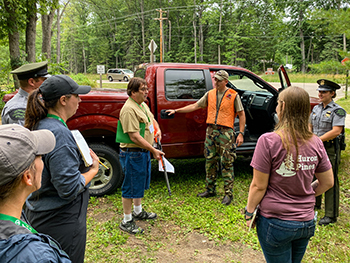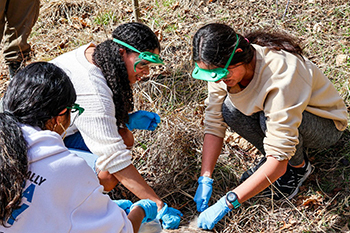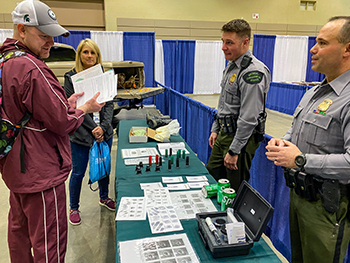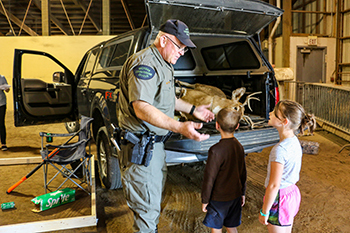Showcasing the DNR: Conservation officers teach wildlife crime scene investigation techniques
By KATIE GERVASI
Communications representative, Law Enforcement Division
Michigan Department of Natural Resources
As part of their mission to protect the state’s natural and cultural resources, the environment and the health and safety of the public through effective law enforcement and education, Michigan Department of Natural Resources conservation officers have found innovative ways to deliver science-based education.
It started during the 1940s, when the DNR, then called the Michigan Department of Conservation, hosted herds of higher education students at the Ralph A. MacMullan Conference Center in Roscommon. For nearly 50 years, six Michigan universities sent students there to learn about conserving Michigan’s forestry, fish and wildlife resources.
The program was eventually phased out, but a new initiative was launched in 2008 called the Academy of Natural Resources – a training for educators to learn ways to incorporate natural resources into the classroom.

During the weeklong training, educators lodge at the RAM Center and spend each day learning about natural resources and the laws that protect and preserve them for future generations.
“The natural resources have a great connection to science, technology, engineering and math,” said Kevin Frailey, education services manager with the DNR. “Fisheries, wildlife, forestry, law – these all apply STEM concepts.”
Since 2008, more than 500 educators have attended the academy.
On law enforcement day during the training, educators – whose teaching subjects regularly vary from chemistry to English – have the opportunity to become a conservation officer for a day to investigate a fish and wildlife crime.
Jon Gray, a retired eighth grade science teacher and police officer, was operating a program similar to the DNR’s academy, through the Safari Club International Novi Chapter. Gray teamed up with the Academy of Natural Resources coordinators as an SCI representative and sponsor, and eventually became involved in academy programming.
“Combining my classroom experience as a science teacher with the experience of the conservation officers, we tied it to scientific standards and principles,” Gray said.
DNR Sgt. Mark Papineau also talked about tying together concepts educators are teaching Michigan students with the DNR’s law enforcement work.
“We looked at school curriculums and compared them to how we use the claim evidence reasoning theory,” Papineau said.
Educators become the students and learn about the history of COs, who they are and what they do.
|

“We teach them essential functions, including field observations, with objects that COs look for every day – essentially, training your eyes and brains to look for different things that aren’t common in nature, especially in the fall,” Papineau said.
Following the classroom portion of the academy training, educators are split into groups, where they become conservation officers and receive a mock complaint from the DNR’s Report All Poaching hotline.
Upon arriving at one of two scenes – either a fishing violation along the shores of Higgins Lake or a deer violation in the woods – educators secure the premises and interview suspects, with COs outfitted and acting as the game violators.
The student COs pick their evidence, document it, then return to the classroom to apply the claim evidence reasoning theory for an affidavit to present to the magistrate to request an arrest warrant.
“Our goal is to provide teachers a creative and unique way to apply the CER theory in the classroom, using real life skills,” Papineau said. “The day ends with a teacher presenting their case in a mock courtroom setting to a CO acting in the role of a judge.”
The day is a hit, and academy organizers are looking for ways to expand the highly rated program to more educators.
“People are fascinated with crime,” Frailey said. “There are millions of crime shows, documentaries and investigation techniques. At the same time, people are fascinated with wildlife. There’s a link with teachers who see how they can use the fascination of crime and wildlife and apply it in the classroom.”
With an existing DNR presence at the Michigan Science Teachers Association annual event in Lansing, the event was the perfect opportunity to host a wildlife crime scene.
In 2023, COs setup their first wildlife crime scene in a 40-square-foot indoor space.
|

“We created a self-guided tour where teachers received a handout with information to conduct an investigation,” Papineau said. “They’re a CO on patrol and dispatched to a trespassing complaint where a landowner witnesses a violation.
“The teacher then walks around an 8-foot by 8-foot scene to document evidence – a shotgun casing, litter and boot prints. At the next scene, the teacher visits a campsite where they observe what appears to be the suspects’ vehicle and they collect more evidence – a shell casing in the vehicle, boot impressions to compare from the first scene and they locate a dead deer.”
At the third exhibit, officers walk teachers through all the evidence and how they process it, including what can be gathered from different pieces of litter, shoe impressions, fingerprints, bullet impressions and determining a deer’s time of death.
“When teachers talk to kids about why science is important and kids ask, ‘when am I ever going to use this?’ teachers can give an example how COs use CER every day,” Gray said.
Since the inaugural 2023 wildlife crime scene in Lansing, COs have taken the show on the road. The set up in the Kid’s Cave at the National Trappers Convention in July 2023 in Escanaba and as a weeklong career technical education program for Brimley Area Schools at Lake Superior State University.
In March, a group of COs spent the day at Portage Central High School, where juniors and seniors enrolled in a forensic science class participated in the mock crime scene – this time featuring a real deer that was struck by a car the previous day.
“My students loved it,” said James Carrow, science teacher at Portage Central High School, who requested the officers to host the crime scene. “Not a lot of our students are hunters or interact with nondomesticated animals, especially dead ones. At first, they were squeamish but after a couple minutes they grew excited. It was great to see how interested they became and the questions they were asking.”
Students learned about and wore personal protective equipment to take tissue, blood and hair samples and collect swabs for DNA analysis. They practiced bagging and labeling evidence, collecting shotgun shells and soil samples, taking tire impressions and looking for footprints and other items that might have been dropped by a game-law violator.
|

“To have professional officers guide us, using an actual deer, collecting real samples, discussing the process behind it – really helped make what we’re learning in class real for the students,” Carrow said.
The next day, when Carrow conducted a debriefing session with students, he said several of them expressed new interest working in a DNR-related field.
“This helped show different jobs that are out there,” Carrow said. “We talk about traditional city police officers and labs. Not many students knew what a CO did, they just assumed they hike in the woods.”
The wildlife crime scenes are also building important relationships between law enforcement officers and their communities.
“When most of what you hear about law enforcement is negative, it makes it difficult for people to walk away with a positive police reaction,” Carrow said. “Providing kids with the chance to see the good and important work conservation officers do is always a positive – our students came away with very positive feelings about the officers.”
Michigan conservation officers are fully commissioned state peace officers who provide natural resources protection, ensure recreational safety and protect citizens by providing general law enforcement duties and lifesaving operations in the communities they serve.
Find out more about DNR conservation officers at Michigan.gov/ConservationOfficers.
|
Check out previous Showcasing the DNR stories in our archive at Michigan.gov/DNRStories. To subscribe to upcoming Showcasing articles, sign up for free email delivery at Michigan.gov/DNREmail.
Note to editors: Contact: John Pepin, Showcasing the DNR series editor, 906-226-1352. Accompanying photos and a text-only version of this story are available below for download. Caption information follows. Credit Michigan Department of Natural Resources, unless otherwise noted.
Text-only version of this story.
Evidence: Michigan Department of Natural Resources conservation officers Charlie Jones and Ben McAteer present pieces of evidence that COs collect to investigate wildlife crimes with educators attending the Michigan Science Teachers Association annual conference.
Hunter: A group of educators participating in the weeklong Academy of Natural Resources spent time with conservation officers learning what types of evidence they collect when talking to suspects. The educators had their chance to interview a suspect during a mock crime scene where they encounter a conservation officer who is pretending to be an illegal hunter.
Sample: Juniors and seniors in a forensic science class at Portage Central High School learned about personal protective equipment and how to collect tissue, blood and hair samples from a deer that was struck by a car the previous day. (Photo courtesy of Portage Public Schools.)
Scene 1: Children attending the National Trappers Convention, July 2023 in Escanaba, look for pieces of evidence in a scene setup to imitate a wooded area.
Scene 2: CO Rich Stowe talks to two children at the National Trappers Convention about pieces of evidence located in a truck that would help COs solve a deer poaching crime.
|